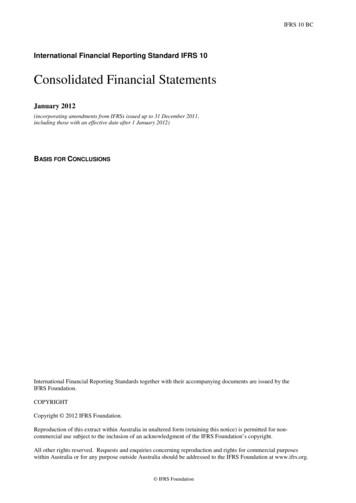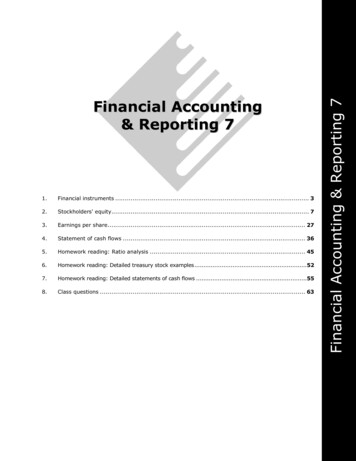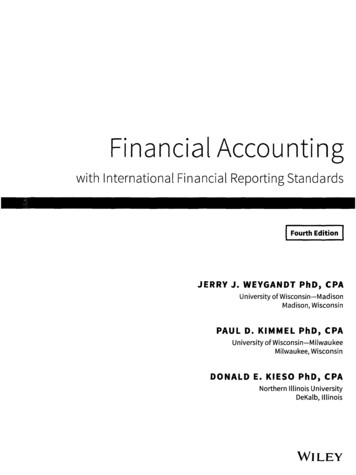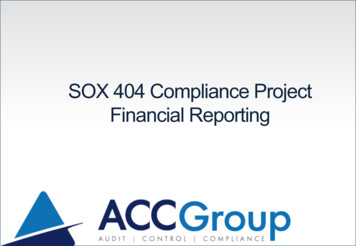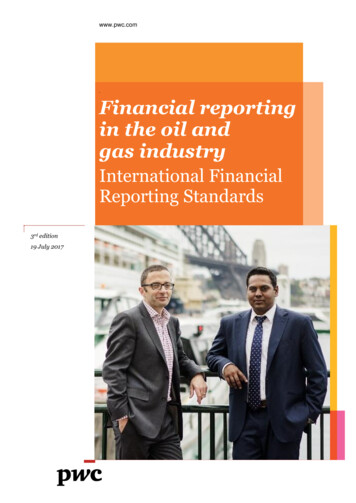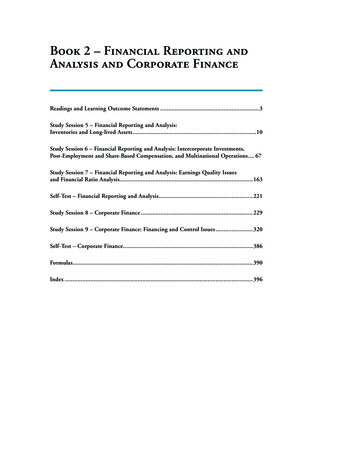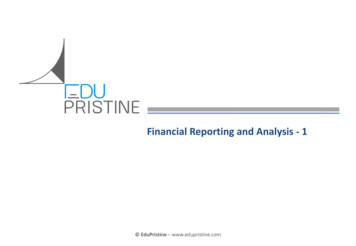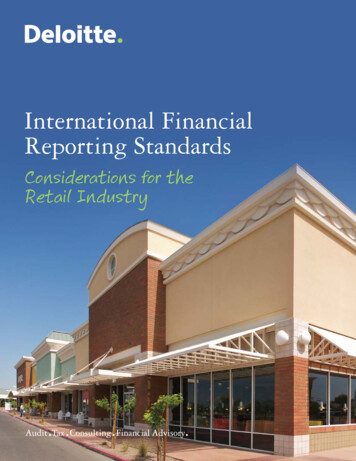
Transcription
International FinancialReporting StandardsConsiderations for theRetail Industry
Table of ContentsKey Differences between U.S. GAAP and IFRS for Retail Companies .3Inventories .3Leases .4Impairment of Long-Lived and Indefinite-Lived Assets .4Property, Plant and Equipment.6Additional Technical Accounting Differences .7What Now?.8
International Financial Reporting StandardsConsiderations for the Retail IndustryBy now, you’ve likely heard the increasing warning signals about the inevitable movement toward International Financial Reporting Standards(IFRS) as a single set of globally accepted accounting standards.Recent events suggest that reporting under IFRS will be allowed or required for most public companies in the U.S. and around the globe withinthe next few years. On November 14, 2008, the SEC issued its long-awaited proposed IFRS “roadmap” outlining milestones that, if achieved,could lead to mandatory transition to IFRS starting in fiscal years ending on or after December 15, 2014. The roadmap also contains proposedrule changes that would give certain U.S. issuers the early option to use IFRS in financial statements for fiscal years ending on or after December15, 2009. The SEC believes that “the use of a single, widely accepted set of high-quality accounting standards would benefit both the globalcapital markets and U.S. investors by providing a common basis for investors, issuers and others to evaluate investment opportunities andprospects in different jurisdictions.” The roadmap also notes that IFRS has the potential “to best provide the common platform on whichcompanies can report and investors can compare financial information.” The SEC is seeking comments on numerous questions raised in theproposed roadmap. The comment period is expected to run until midto-late February 2009.Retail Competitive LandscapeThe proposed roadmap outlines seven milestones. Milestones 1–4discuss issues that need to be addressed before mandatory adoptionof IFRS:1. Improvements in accounting standards.2. Accountability and funding of the International AccountingStandards Committee Foundation.CompanyU.S.GAAPAholdBest BuyIFRSInternationalOperationsRevenue*(Billions)xx 42x 40xCarrefourxx 1253. Improvement in the ability to use interactive data for IFRS reporting.Casinoxx 384. Education and training on IFRS in the United States.Costcoxx 66Milestones 5–7 discuss the transition plan for the mandatory use ofIFRS:CVS CaremarkxHome Depotx5. Limited early use by eligible entities: This milestone would givecertain U.S. issuers the option of using IFRS for fiscal years endingon or after December 15, 2009.J.C. Penneyx6. Anticipated timing of future rule making by the SEC: On the basisof the progress made on milestones 1–4 and experience gainedfrom milestone 5, the SEC will determine in 2011 whether torequire mandatory adoption of IFRS for all U.S. issuers. Potentially,the option to use IFRS could also be expanded to other issuersbefore 2014.Kroger7. Implementation of mandatory use: The roadmap raises manyquestions, including whether the transition to IFRS should bephased in. According to the roadmap, large accelerated filers wouldbe required to file IFRS financial statements for fiscal years endingon or after December 15, 2014, then accelerated filers in 2015, andnonaccelerated filers in 2016.Under the proposed roadmap, U.S. issuers that meet both of thefollowing criteria would be eligible to use IFRS earlier in financialstatements for fiscal years ending on or after December 15, 2009:Kingfisher 76x 20xxxx 9x 48xLiberty MediaLowe’sxMacy’sxOffice DepotxPPR 77 19 70 26xx 15x 30x 51Sears HoldingsxSupervalux 34Targetx 63TescoxWalgreenxWal-Martxx 95 55x 379*Obtained from the most recent annual publicly filed report.Deloitte refers to one or more of Deloitte Touche Tohmatsu, a Swiss Verein, and its network of member firms, each of which is a legally separate andindependent entity. Please see www.deloitte.com/about for a detailed description of the legal structure of Deloitte Touche Tohmatsu and its member firms.1
The U.S. issuer is globally among the 20 largest listed companies worldwide in its industry, as measured by market capitalization. IFRS, as issued by the International Accounting Standards Board (IASB), is used as the basis for financial reporting more often than any otherbasis of accounting by the 20 largest listed companies worldwide in the U.S. issuer’s industry, as measured by market capitalization.An issuer that meets these criteria and chooses to use IFRS (an “IFRS issuer”) must prepare its financial statements in accordance with IFRS asissued by the IASB. Issuers electing to file IFRS financial statements with the SEC would be required first to do so in an annual report and wouldnot be able to file IFRS financial statements with the SEC for the first time in a quarterly report, registration statement, or proxy or informationstatement.Investment companies; employee stock purchase, savings, and similar plans; and smaller reporting companies, as defined by the SEC, areexcluded from the definition of an “IFRS issuer” in the proposed roadmap and therefore would not be eligible to early adopt IFRS.For more information on the SEC’s action, visit www.deloitte.com/us/ifrs.While IFRS is similar to U.S. GAAP in many respects, there are still some significant differences. For example, IFRS specifically prohibits the use ofthe last-in, first-out (LIFO) costing method, and it provides the ability to reverse inventory write-downs, revalue fixed assets, and reverse longlived and indefinite-lived impairment charges (with the exception of goodwill).Many international retailers have already adopted IFRS. Some of the benefits that have been derived from this shift include increasedtransparency and consistency of financial information, more efficient use and availability of global resources, streamlined internal controls,additional access to capital, simplified cross-border M&A transactions, and opportunities for improved cash management and income taxplanning.In our 2008 Global Powers of Retailing report, we noted that slow growth in many mature markets and not-to-be-missed-opportunitiesin emerging markets, particularly China, India and Russia, are powerful driving forces of globalization in the retail world today. While U.S.retailers are among the least likely right now to have foreign operations compared to retailers based in other countries, globalization is slowlyaccelerating. The U.S. retailers included in the top 250 retailers in the world (based on revenues) operate in an average of 3.7 countries, up froman average of only two countries 10 years ago. This increasing global diversification in retail creates yet another reason for U.S. companies tounderstand the benefits of a level financial reporting playing field.The potential benefits of transitioning a multinational organization to a single set of accounting standards do not come without a cost, however.Conversion to IFRS will require a significant commitment of specialized resources in order to properly analyze and plan implementation.Companies must assess and create policies with a global understanding of the processes and goals of the entire organization, train theappropriate people in the organization (often across cultural and language barriers) and implement appropriate information systems andoperational processes.Key Impacts of IFRS ImplementationTechnical AccountingProcess and Statutory ReportingTechnology InfrastructureOrganizational Issues Overall approach to IFRSimplementation Internal controls and processes,including documentation andtesting General ledger and chart ofaccount structure, includingperformance metrics Tax structures Management and internalreporting packages Global consolidation First time adoption policyconsiderations, includingreporting dates and use ofexemptions Ongoing policy considerations, including alternativesand approach to “principles” Global reporting packages Sub-system issues related toconfiguration and data capture Statutory reporting, including“opportunities” around IFRSadoption Capabilities to manage multipleGAAP accounting duringtransition Treasury and cashmanagement Legal and debt covenants People issues, includingeducation and training, andcompensation structures Internal communications External and shareholdercommunicationsOne significant challenge is a shift in how accounting policies are developed, written and applied. Since IFRS focuses much more on principlesrather than the rules-based approach under U.S. GAAP, the implementation of IFRS will involve a new way of thinking about accounting andfinancial reporting. This new way of thinking places greater emphasis on interpretation and application of principles — with a particular focuson the substance and underlying economics of a transaction, and on transparency of financial information rather than uniformity of practices.This requires a renewed focus on professional judgment in arriving at accounting conclusions. A cultural shift to IFRS may prove very challengingbecause most accounting and finance professionals in the U.S. are accustomed to detailed guidance and strict conformity of application.Companies will need to look at accounting and financial reporting in a new way.While IFRS allows for a more principles-based approach, there are also published standards and rules that contain significant differences fromU.S. GAAP. The purpose of this publication is to provide insight on the potential impact to retailers that may result in a conversion from U.S.GAAP to IFRS, including technical accounting differences and the potential impact on income taxes and information systems. Note that nosummary publication can do justice to the many differences in the details that exist between IFRS and U.S. GAAP and this document only focuseson the areas with a broad impact to the retail industry. In addition, even if the overall approach taken in the guidance is similar, there can bedifferences in the detailed application, which could have a material impact on the financial statements.2
Key Differences between U.S. GAAP and IFRS for Retail CompaniesIFRS guidance is currently comprised of 38 standards and 26 interpretations. Some of the more significant differences between U.S. GAAP andIFRS of particular interest to retailers are discussed below, along with their associated impact on tax, processes and systems.Inventories: International Accounting Standard (IAS) 2Accounting MethodsThe cost of inventory under both U.S. GAAP and IFRS generally includes direct expenditures of getting inventories ready for sale, includingoverhead and other costs attributable to the purchase or production of inventory. IAS 2 specifically requires use of either the first-in, firstout (FIFO) or the weighted-average cost method, but allows the standard cost method or the retail method for convenience if the resultsapproximate cost. Further, IFRS requires that the same costing formula be used for all inventories with a similar nature and use to the entity.Therefore, retailers may not be able to use the retail method of accounting to compute cost in one operating segment and the weighted averagemethod in another.The Tax DilemmaUnder U.S. GAAP, during periods of rising prices, the LIFO costing method leads to higher recognized costs of sales, and thusreduces taxable income. Under Internal Revenue Service (IRS) rules, retailers using the LIFO method must conform theirfinancial reporting method to LIFO. But under IFRS, use of the LIFO costing method is explicitly not permitted. The adoptionof IFRS for financial reporting purposes could result in significant tax consequences, as its stated preclusion of LIFO for financialreporting would violate current IRS conformity requirements for those using LIFO for tax purposes.Some business observers speculate that the U.S. Congress and the IRS will be compelled to address this issue should IFRS bemandated, perhaps by offering a one-time conversion opportunity that limits the tax liability. Companies should closelymonitor developments in this area and may want to begin the analysis to estimate the dollar cost of converting from LIFOunder the current IRS conversion rules.Carrying ValueUnder U.S. GAAP, inventories are required to be stated at the lower of cost or market (LCM), with market defined as current replacementcost. Market should not exceed net realizable value (defined as the estimated selling price in the ordinary course of business less reasonablypredictable costs of completion and disposal) or be less than NRV reduced by an allowance for a normal profit margin. For U.S. GAAP purposes,application of the LCM approach leads to an acceptable range of practice among retailers, given the floor and ceiling concept in the definition ofmarket.Under IFRS, inventories are stated at the lower of cost or net realizable value (defined as the estimated selling price in the ordinary course ofbusiness less the estimated cost of completion and the estimated cost necessary to make the sale). Under IFRS, there is no concept of reducingNRV to allow for a normal profit margin. While the definitions of carrying value under U.S. GAAP and IFRS appear to be only slightly different,the outcome may be significantly different depending on a retailer’s current practice for determining LCM.Reversal of Write-DownsA new assessment is made of net realizable value in each subsequent period. Under IFRS, unlike U.S. GAAP, when the circumstances thatpreviously caused inventories to be written down below cost no longer exist or when there is clear evidence of an increase in net realizable valuebecause of changed economic circumstances, the amount of the write-down is reversed so that the new carrying amount is the lower of the costor the revised net realizable value (i.e. the reversal is limited to the amount of the original write-down). This occurs, for example, when an itemof inventory that is carried at net realizable value because its selling price had declined, is still on hand in a subsequent period and its selling pricehas increased. Any impairment or reversal is recorded to cost of sales in the period in which it occurs.Summary of Impact on InventoriesKey AccountingDifferencesPotential ImplicationsFinancial StatementsProcess/Systems LIFO prohibited Valuation of inventory Inventory system changes Consistency ofaccounting method Impairment charges Processes around reversal ofinventory impairment Measure at cost or NRVTaxes/Other Potential significant cost if LIFOis eliminated Impact from change invaluation Use slightly differentvaluation method Reversal of impairment3
Leases: IAS 17 & International Financial Reporting Interpretation Committee (IFRIC) 4The scope of IFRS lease guidance includes the right to use other types of assets in addition to property, plant, and equipment (e.g., certainintangible assets). Intangible assets are within the scope of IAS 17 if rights are established for the exclusive use of the intangible asset. Forexample, brands and trademarks often are licensed exclusively and therefore are included in the scope of IAS 17.Lease ClassificationUnder IFRS, lease classification (e.g., operating or finance — the IFRS term for capital lease) depends on similar criteria as U.S. GAAP, but withoutthe bright-line guidance. For example, IAS 17 states that the lease term is for the “major part” of the economic life (not a strict 75 percent), orthe present value of the minimum lease payments at lease inception is for “substantially all” of the fair value (not 90 percent). The basic IFRSprinciple is: if the lease does not transfer substantially all risks and rewards incidental to ownership to the lessee, then the lease is classified as anoperating lease.Leases of Land and BuildingsU.S. GAAP generally requires the lease of land and building elements to be accounted for as a single unit if certain criteria are met. IAS 17requires the lease of land and building elements to be accounted for separately for a lease classification unless the land element is not material.The present value of the minimum lease payments, including any lump-sum upfront payments, is allocated between the land and buildingelements in proportion to their relative fair values at the inception of the lease.Lease ExpenseSimilar to U.S. GAAP, lease expense should be recognized on a straight-line basis over the lease term, unless another systematic basis is morerepresentative of the pattern of benefit. Lease incentives (such as free rent periods) are recognized as a reduction of expense over the lease term.Sale-Leaseback TransactionsUnder U.S. GAAP, separate requirements exist for sale and leaseback transactions involving real estate. Under IFRS, there is no difference inaccounting between sale and leaseback transactions involving real estate and non-real estate assets.Under U.S. GAAP, a gain or loss on a sale-leaseback transaction is deferred and amortized over the lease term with limited exceptions regardlessof the leaseback classification (seller retains less than substantially all of the use of the leased asset). Under IFRS, the timing of recognition ofa gain or loss on a sale and leaseback transaction differs depending on the classification of the leaseback. A gain or loss on a finance lease isdeferred and amortized over the lease term. A gain or loss on an operating lease is recorded immediately if the sales price is established at fairvalue. Otherwise, it should be deferred and amortized over the lease term.Summary of Impact on LeasesPotential ImplicationsKey Accounting DifferencesFinancial Statements Determining lease classification Potentially more capital leases Break out land and building intoseparate lease Income recognition fromoperating sale-leasebacks If known, use implicit rate fordiscount rate even if higher thanincremental borrowing rate Recognize gain on sale-leasebackfor operating lease immediatelyProcess/Systems Lease classification systemchanges Increased diligence todetermine separate value ofland and building, identifyimplicit rate, and applyguidanceTaxes/Other Impact from change inlease classification andsale-leaseback gains Covenants No specific guidance for specializedleases (leveraged-leases, etc.)Impairment of Long-Lived and Indefinite-Lived Assets: IAS 36The indicators, timing and levels for long-lived and indefinite-lived asset impairment testing are similar under IFRS and U.S. GAAP.Goodwill and other indefinite-lived intangibles are tested for impairment at least annually, or more frequently if an indicator is present. Otherlong-lived assets are reviewed at the end of each reporting period for any indication of impairment, and tested for impairment if necessary. IFRSrequires impairment testing at the “cash-generating unit” (CGU) level, which may result in a l
overhead and other costs attributable to the purchase or production of inventory. IAS 2 specifi cally requires use of either the fi rst-in, fi rst-out (FIFO) or the weighted-average cost method, but allows the standard cost method or the retail method
